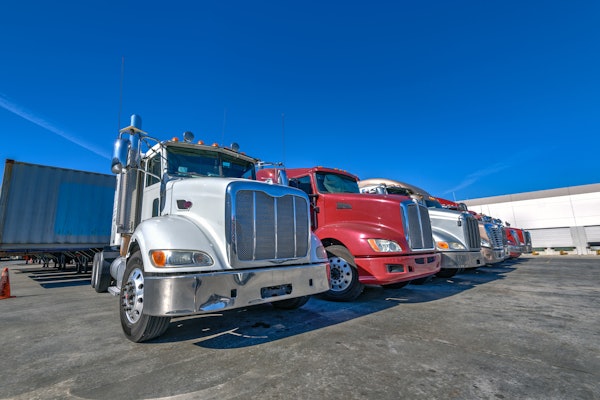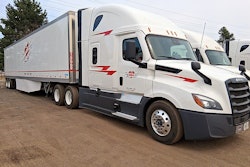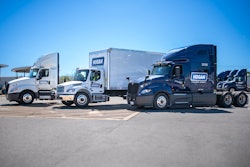Per Carlsson was named president and CEO of Volvo Trucks North America, effective Jan. 1.
Carlsson currently is responsible for Volvo Powertrain Sweden and previously was CFO at Volvo Trucks. Peter Karlsten, the current head of Volvo’s North American truck business, becomes president and CEO of Volvo Powertrain on Dec. 1.
Bendix Commercial Vehicle Systems, Dayton Parts, Haldex, Odyssey Battery and SKF are accepting applications for the 2007 Technician of the Year Award program. Until Dec. 1, fleet managers may nominate a technician by visiting www.techoftheyear.com.
Freightliner LLC announced the upcoming change of its corporate name to Daimler Trucks North America.
Goodyear has been named an International Truck primary tire supplier.
John Boler – president, CEO and chairman of The Boler Co. – said that Matthew Boler is succeeding him as president and CEO of the Itasca, Ill.-based company. The company also announced that Gary E. Gerstenslager was promoted to president and CEO of Hendrickson.
Wabash National said its DuraPlate dry van trailer meets the technical specifications for the U.S. Environmental Protection Agency’s SmartWay certification mark.
Isuzu Commercial Truck of America announced the availability of its 2008 gas-powered Isuzu N-Series low-cab-forward trucks. The new models feature the Vortec 6.0L V8 engine with 325 horsepower (up from 300 hp previously) and a Hydra-Matic 4-speed automatic transmission with lockup torque converter and overdrive.
The nation’s top 12 diesel mechanics walked away from the TMCSuperTech event in Nashville, Tenn., with Panasonic Toughbook 19 rugged mobile computers.
Dodge says its new “super-sized” Sprinter, starting at $33,900, offers new choices, features and innovations.
Grote Electronics, a division of Grote Industries, officially dedicated its new 40,000-square-foot manufacturing facility.
Landa Cleaning Systems is extending its product line to include a new line of waste oil heaters.
Eaton Corp. announced that the company’s family of automated medium- and heavy-duty transmissions now includes 49 different configurations for virtually all vocations.
Bridgestone Firestone North American Tire and the National Football League have entered into
a multiyear integrated marketing partnership that designates the Bridgestone brand as the first “Official Tire of the National Football League.”
With its new DD15, Detroit Diesel says it has flexed its manufacturing, financial and developmental muscles, to make strides in technology, performance, cost savings and support.
“Often, selecting an engine for a heavy-duty truck meant trade-offs,” says Chris Patterson, president and chief executive officer of Freightliner LLC, soon to be renamed Daimler Trucks North America. “Performance or fuel economy? Durability or drivability? Long service intervals or inexpensive maintenance parts?
“That era is now officially over,” Patterson says. “With the DD15, a trucker gets the best of everything.”
Unveiled Oct. 19 at Detroit Diesel’s Redford, Mich. plant and available by next summer, the DD15 – a 14.8-liter six-cylinder in-line diesel – represents $1.5 billion and five years of development, a modernized plant and employee structure, and stronger service and support, the company says.
“This is not only the introduction of a new heavy-duty engine, but also the first application of our global heavy-duty engine platform that will power all commercial heavy-duty trucks in the Daimler family worldwide,” says Daimler Trucks head Andreas Renschler. Detroit Diesel will introduce the 12.8-liter DD13 in 2009 and the 15.6-liter DD16, with up to 600 hp and 2,050 lb-ft of torque, in 2010.
Detroit Diesel says the DD15, compared to the Series 60 it replaces, has:
* A stronger, stiffer iron-alloy block with higher-capacity oil and coolant flow and forged-steel crankshaft and pistons designed for larger-diameter, more durable main bearings;
* A lighter, stronger one-piece cylinder head made of compacted graphite-iron, with two cams and four valves per cylinder on shortened intake and exhaust ports;
* Integrated engine brakes, hydraulically operated and electronically controlled, maintaining downhill speed with up to 575 braking horsepower;
* A common-rail fuel injection system with amplified pressure that individually shapes each inner-cylinder spray pattern; and
* Turbo-compounding technology that converts once-wasted downstream exhaust gas into about 50 “free” horsepower.
Performance is one result, according to Detroit Diesel; in a side-by-side 0-60 mph race, the DD15 bested the S60 by eight seconds. Cooling fans sap energy, but the DD15 can run hotter, dramatically reducing fan on-time, the company says.
Faster, easier maintenance also is included, Detroit Diesel says; the DD15 has up to 50,000-mile oil, oil-filter and fuel-filter lifecycles, and up to 60,000 miles between overhead lash adjustments. Its oil, coolant, exhaust gas recirculation and fuel system components are above the frame rail and grouped close together for easier access.
Overhead cams and an integrated engine brake are designed to ease top-end inspection and maintenance, and top-load cartridge oil and fuel filters are meant to be more easily, neatly changed and properly discarded.
Detroit Diesel has dialed-in service and support for the DD15, with Freightliner’s NAFTA-wide parts, service and training network. A Daimler-Mitsubishi Fuso partnership starts in January 2008, and 90 percent of all American, European and now Asian DD15 parts are interchangeable; any plant can make most parts for DD15s on any continent, according to the company.
Freightliner’s parts distribution system will be fully engaged and functioning before the first part is ordered or preventive maintenance is scheduled, says David Stiler, Detroit Diesel’s marketing director.
Training is under way, too. “We’re already graduating technicians who will be prepared to accurately diagnose and repair any potential DD15 service need that might arise,” Stiler says.
Cost savings are a natural result of better performance and easier, faster maintenance, according to Detroit Diesel, calling the DD15’s price tag “competitive.” The engine also uses up to 5 percent less fuel, and it creates and uses horsepower more efficiently, the company says.
– Andy Haraldson
Volvo 2010 engines go to Talon
On Sept. 13, Volvo Trucks North America presented Talon Logistics with five 2010-spec’d Volvo VN day cabs equipped with selective catalytic reduction (SCR). Talon Logistics is the distribution unit of Pittsburgh-based Giant Eagle Inc., a major food retailer and distributor. The carrier had accumulated more than six million miles in an earlier SCR field test with Volvo that began in 2002.
“This is a milestone in achieving cleaner air, while delivering the fuel economy, reliability and performance our customers demand,” said Peter Karlsten, president and chief executive officer of Volvo Trucks North America. “We know from Volvo’s experience in other markets that SCR is the best technology for producing very low NOx emissions, plus excellent fuel economy.”
Volvo’s 2010 engine solution builds upon its current emissions reduction technology, with a diesel particulate filter (DPF) and exhaust gas recirculation (EGR). Volvo also draws upon the Volvo Group’s experience with SCR in Europe, where more than 100,000 trucks have been built by the Group to date.
Volvo plans to place 11 trucks with SCR technology into field test service this year, with additional trucks entering service in 2008.
SCR is an aftertreatment technology that injects a water-based solution containing urea, into an engine’s hot exhaust stream to reduce emissions of nitrogen oxides (NOx). The diesel exhaust fluid, in conjunction with a catalyst in the exhaust aftertreatment system, breaks down the NOx into harmless nitrogen and water vapor. Urea is an organic nitrogen-containing compound commonly used in agriculture as a fertilizer and is classified by the U.S. Environmental Protection Agency as a nonhazardous substance.
EquipmentPuzzler
Back in September, we asked: What’s a simple way to convert degrees Celsius to Fahrenheit? The answer, which no one got, is to multiply degrees C by 9/5 and add 32. Hey, don’t get hot under the collar – you’ve got another chance to win an elegant CCJ pen and Air Brake Book, if you’re the first to send the correct answer to this month’s Puzzler to [email protected], or if you send in a Puzzler of your own and we use it.
This month’s Puzzler: In keeping with our metric adventure (this should be easy), what does -40 degrees C equal in degrees F?









